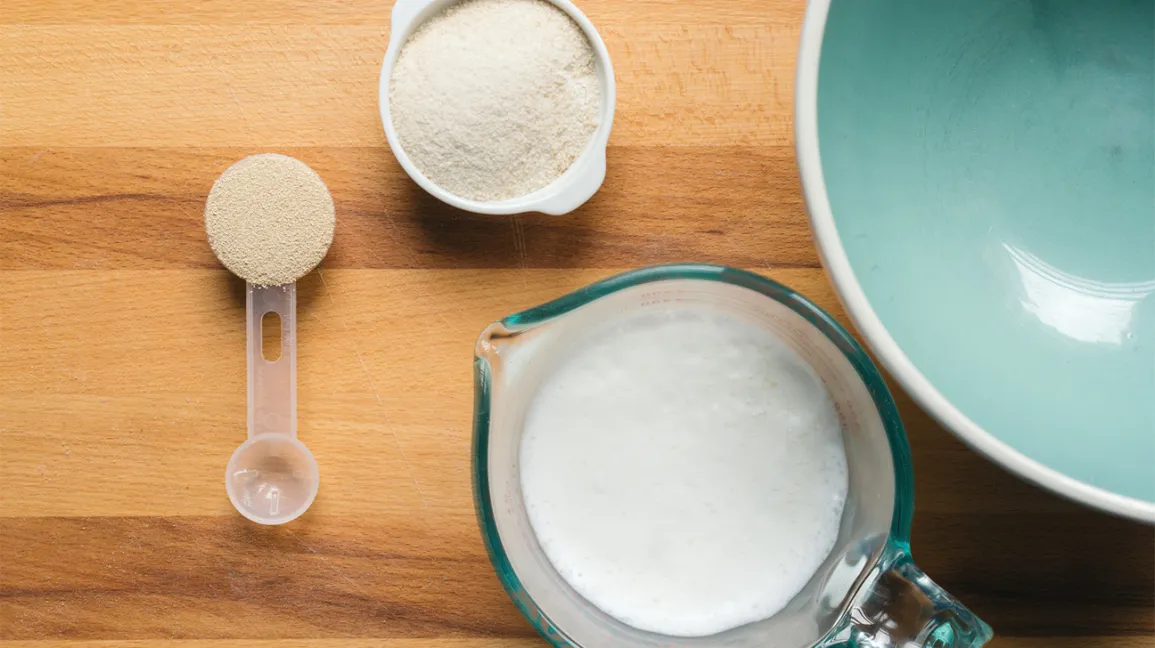You are about to prepare bread or some other recipe and you only need one ingredient: yeast. Whether it’s because yeast is in short supply, you can’t go out and buy it, or you just want to experiment with other ingredients, it’s sure to come in handy to know how to substitute yeast.
With this in mind, we bring you the different ways to replace yeast, the amount you should use of each substitute and how to do it, all with ingredients you already have at home! Very valuable information for lovers of confectionery and pastries.
Yeast Substitutes by Type
If we want to correctly substitute the ferment, it is essential to know the types of yeasts and how they work, even if it is in a very basic way. Let’s see the main types of yeast that exist:
Boosters (lauding agents or chemical emulsifiers)
The boosters, although they are commonly called yeast, do not behave the same as yeast, although at first glance they seem to give the same result. Chemical emulsifiers are not suitable for long fermentations, which is why they are not recommended for bread recipes or the like.
These ingredients introduce air into each preparation, raising and fluffing the resulting product, but nothing more. Leavening agents are added to liquid batters near the end of preparation, and must be baked immediately to produce the proper effect.
These products are used in recipes such as biscuits, cakes, cookies, muffins, cakes, tarts, etc. The main leavening agents are baking powders or chemical yeast, and raising agents. These ingredients can be substituted with the following natural boosters:
- Bicarbonate accompanied by some acid compound (lemon and other natural citrus fruits, some fermented milk products or cream of tartar).
- Eggs well beaten. Snowy whites and yolks beaten until very creamy and almost white add enough air to the liquid masses.
- Carbonated water.
- Fruit salt.
- Self-rising flour
- Lemon juice (only use it in recipes with citrus flavors).
- Molasses (has acidic properties similar to baking soda).
Ferments (yeasts)
These ingredients give the final product the organoleptic characteristics that will define it (texture, size, flavor and aroma). In addition, they provide a certain amount of nutrients that enrich the product, due to their healthy microorganisms.
They are added at the beginning of the preparation so that they take effect during the resting times. Thus, the consistent masses are fermented and the final product rises. The yeasts are used for preparations such as bread, pizzas, donuts, roscoe’s, Christmas sweet bread, empanadas, brioche, etc.
There are four main types of ferments for bread and pastries: fresh or pressed yeast, instant dry yeast, active dry yeast and liquid yeast. These products can be substituted with the following most popular natural yeasts:
- Mother dough.
- Sourdough with fermented fruit water.
- Potato yeast.
- Potato water fermentation.
- Beer yeast.
- Raisin fermentation.
- Apple yeast
- Liquid fruit ferment.
- Corn yeast.
- Beer yeast.
- Beer (preparing a beer pre-ferment).
How to substitute yeast in bread?
Preparing good bread depends largely on the yeast you use, since this product takes care of the fermentation. If the fermentation process fails, you will end up with flattened, hard, dry and unappetizing bread.
Yeast used to make bread is usually dried or fresh; however, there are many other options you can make at home if you can’t find it, such as fruit and vegetable ferments.
These are prepared from fruits or vegetables that are left to ferment for several days, during which the microorganisms responsible for making the bread grow, proliferate. Fruit or vegetable yeast is very similar to sourdough and has all its advantages, since it provides the bread with better characteristics (better flavor and texture, as well as more nutrients and greater durability).
Now, if you want to know how to substitute fresh yeast or dry yeast in bread, the important thing is to take into account the cups of flour that they ask for:
- Homemade Fruit or Vegetable Yeast– For 1 cup of flour, 2 tablespoons of ferment are used.
- Sourdough: For 1 cup of flour, use 50 grams of sourdough. If you want to use this type of ferment, visit our article How to make sourdough and our sourdough bread recipe.
- Brewer’s yeast: for 1 cup of flour, 1/2 tsp. of brewer’s yeast. Brewer’s yeast and baker’s yeast have the same strain of fungus, although they grow at different rates.
- Beer– For 1 cup of flour, use 150 ml of beer. To use this option, you must subtract the amount of beer you use from the other liquid ingredients, since beer provides extra liquids. Use craft beer, since the commercial one has inactive microorganisms.
Another less appetizing option to replace the yeast would be to use a chemical booster or some raising agent, since they do not meet what is necessary to give the bread its main characteristics.
However, as every rule has its exception, there are some recipes that use boosters, such as Irish soda bread, which contains baking soda. For this reason, we think that the following data could be useful:
- Baking powder or chemical yeast: Use 1 tsp. of baking powder for every cup of flour called for in the recipe.
- Baking soda: Use ¼ tsp. of baking soda for every cup of flour.
Finally, it is important to consider some tips for the proper use of the different types of yeast. Here are the most essential:
- If you make breads with a lot of fat or sugar, double the amount of yeast. This applies to any yeast you use, commercial or homemade.
- If you use fruit or vegetable yeast, sourdough or beer, you can prepare a pre-ferment. Many expert bakers prefer to pre-ferment the yeast before using it. This consists of mixing a little flour, sugar and homemade yeast. This mixture is kept in the fridge and used the next day.
- Homemade yeasts can be added directly to the recipe. Although some professionals prefer to prepare a pre-ferment, you can also use them like conventional yeasts.
- Always balance the amount of liquids in your bread recipe, especially when using high-moisture yeast. In those cases, after adding the yeast, add the water or liquid little by little until the dough reaches the required consistency. Discard the liquid that you have left.
Tip: If you use beer it should be at room temperature, never cold.
How to Substitute Yeast on Pizza?
Homemade pizza is always better! You put what you want, it is cheaper and you have it available whenever you feel like it. But how do you do if you don’t have yeast? There are many ways to make pizza dough without yeast, substituting it with the options that we give you below.
Pizza with baking powder
Although it is common to prepare the pizza with yeast, you can taste a very good express version made with baking powder, but you should know that the final texture will be different. In this case, you will only have to take into account the following proportions:
- Use 1 teaspoon of baking powder for every cup of flour called for in the recipe.
- In the case of this type of quick dough, the procedure is simple and does not require long breaks or much kneading.
Pizza with vegetable or fruit yeast
This yeast provides a special aroma and flavor in the final product much better than common yeast. This is the ratio you need to use it:
- Use 1/2 tsp. of ferment for every cup of flour.
- To incorporate it, just follow the steps of any traditional pizza recipe (several phases of kneading and long breaks), but add the water little by little, until you get the right consistency, and discard what is left over, as the yeast from fruits and vegetables adds extra moisture in the recipe.
Sourdough Pizza
Sourdough is one of the most common substitutes for yeast on pizza. To know how to make any sourdough pizza, follow this ratio:
- Use 50 g of sourdough for each cup of flour(the sourdough must be 100% prepared, that is, half water and half flour).
- To use the sourdough, you can prepare a pre-ferment with it and add it to the rest of the ingredients of the chosen recipe, or add it directly like any yeast. Remember to balance the humidity.
Brewer’s yeast pizza
Brewer’s yeast is used in the preparation of New York-style pizza to give it a strong flavor. To use it, follow this ratio:
- Use 1/4 tsp. of brewer’s yeast for 1 cup of flour.
- In this case, the procedure will be the same as indicated by the pizza recipe you choose.
Tip: Quick pizza dough is best used right away, because it rises better.
How to Substitute Yeast in Donuts?
Donuts, like other pastries, are generally prepared with yeast, either dry or fresh. However, unlike other dough’s, donuts accept almost any yeast substitute very well, even if their final texture changes. Here are some options for substituting yeast in donuts to make yeast-free donuts.
Donut with baking powder
Although baking powder isn’t ideal, it works quite well, providing a very smooth texture, albeit different from traditional dough.
- Substitute 1 teaspoon of baking powder for each cup of flour called for in the recipe.
Donuts with baking powder are considered quick or quick dough donuts, since they do not require much kneading or very long resting times. In this case, the baking powder is incorporated with the dry ingredients (just as with traditional yeast). We recommend that, if you decide on this ferment, you specifically select a recipe for quick donuts, this way you will be better guided in the procedure.
Donut with sourdough
If you want some super tasty, aromatic donuts with an incredible texture, you need to try these donuts with sourdough. The sourdough must be 100%, that is, half water-half flour, and you must use it in this proportion.
- Use 57 grams of sourdough starter for every cup of flour in the chosen recipe.
- Dissolve the sourdough in the water required by the donut recipe. Then, add it together with the flour and integrate it very well. Finally, add the salt and mix again. From here, continue with your chosen recipe. Remember to balance the moisture in the recipe and subtract water and flour.
Tip: Take the sourdough starter out of the refrigerator two hours before and leave it at room temperature.
How to substitute fresh yeast?
Fresh yeast or pressed yeast is fresh pressed microorganisms. This type of ferment fulfills the same function as dry yeast, but lasts only a few weeks.
To replace pressed yeasts with homemade yeasts or other alternative yeasts, directly take into account the cups of flour required in the recipe you want to prepare and the type of dough (for pizza, bread, sweets, etc.). Be guided by the following referential data:
- Homemade fruit or vegetable yeast: For 1 cup of flour, use 1 tbsp. of ferment.
- Sourdough: For 1 cup of flour, use 50 grams of sourdough.
- Brewer’s yeast: for 1 cup of flour, 1/2 tsp. of brewer’s yeast. To stimulate its growth, you should dissolve it in warm water before adding it to your chosen recipe.
- Beer: for 1 cup of flour, 150 ml of beer. Remember, you must subtract liquid from the recipe because the beer will provide extra liquid. This substitute, thanks to its acidity and carbon dioxide, is excellent for pizza, coca and focaccia dough’s.
If you want to replace pressed yeast with dry yeast, keep in mind that every 5 grams of dry yeast is equivalent to 15 grams of fresh or pressed yeast. Thinking about this, we can deduce that: for 1 cup of flour, you should use ½ tsp. of dry yeast. If it is a question of breads with a lot of fat or very sweet, this amount can be doubled.
But if you have no other alternative and need to replace fresh yeast with baking powder, consider that 5 grams of baking powder is equal to 15 grams of fresh yeast. That is:
- You should use 1 tsp. of baking powder for every cup of flour called for in the recipe.
- You should use ¼ tsp. of baking soda for every cup of flour.
In order for you to take better advantage of these yeasts, here are a few very necessary recommendations when using them:
- If it is bread, use the measures described above.
- For high-fat breads and fruit, double the amount of yeast.
- In the case of pizza dough and the like, reduce by half.
- Homemade yeasts allow you to experiment. Depending on what you want, you can play around with the measurements and rest times. For example, if you want more acidity in the dough, use more rest or more yeast.
Tip: If you order brewer’s yeast you must specify that you need the brewer’s yeast and not the nutritional inactive yeast.
How to Substitute Baking Soda for Yeast?
When we talk about swapping yeast for baking soda, we’re not really referring to yeast but to baking powder. This term is often misused, as most baked goods use chemical boosters and never yeast (although there are exceptions). That’s why if you’re wondering how to substitute yeast in biscuits, you’re really wondering how to substitute chemical or royal yeast.
Why can baking powder be substituted for baking soda? Because many baking powders, among their ingredients, contain bicarbonate, a very effective booster. Basically, this ingredient, like all of its kind, adds air to preparations. To substitute baking powder for baking soda, follow this ratio:
- For every cup of flour, use ¼ teaspoon of baking soda + ¼ teaspoon of an acidic ingredient.
- This formula can vary a bit depending on the acidic ingredient: if it is yogurt, milk or buttermilk, you can use up to a glass. If it is vinegar, you can use up to 80 ml, and if you use lemon juice, 70 ml.
- Other acidic products that you can use are: citrus fruits, sour milk (milk combined with some citrus fruit), cream of tartar, vinegar, cider and even the same eggs in the recipe.
Remember, baking soda does not work well for breads and other bakery products (except in some cases), but it is excellent in: biscuits, cakes, cookies, cupcakes, muffins, among other pastry recipes.
Tip: You can use fruit salt as a booster; add the same amount that you would add baking soda, and an acid product.
How to substitute yeast for sourdough?
Sourdough is natural yeast composed mainly of water and flour that ferments for 5 or 7 days to achieve the proliferation of microorganisms that raise the bread.
This type of yeast is very similar to potato yeast and other similar ones due to its durability and the quality it provides to bread. If you want to replace yeast with sourdough, follow these recommendations:
- Use 50 grams of sourdough (100% prepared) for each cup of flour. The result will be a light bread, with alveoli in the crumb, very crunchy and golden crust, uniform size, and soft, creamy and with a fair degree of acidity.
- To integrate the sourdough into the recipe, do it as you do with conventional yeast or prepare a pre-ferment.
- Remember to balance the moisture of the recipe. For example, if you have 65 grams of sourdough and the recipe calls for 500 grams of flour and 200 milliliters of water, first divide the 65 by 2 and it will give you 32.50. Then, subtract 32.50 from 500 grams of flour and another 32.50 from 200 ml of water. Once this is done, you can add the 65 gr of sourdough starter to the recipe, because you reduced the amount of flour and water in it.
- Rest times also vary depending on what you want to achieve. If you want a more intense flavor (more acidic), use longer breaks, and if you want a milder flavor, use shorter breaks. Another way to modify the flavor is by varying the amount of ferment.
Tip: This ferment works best in flours with high percentages of gluten, because they allow long fermentations.



